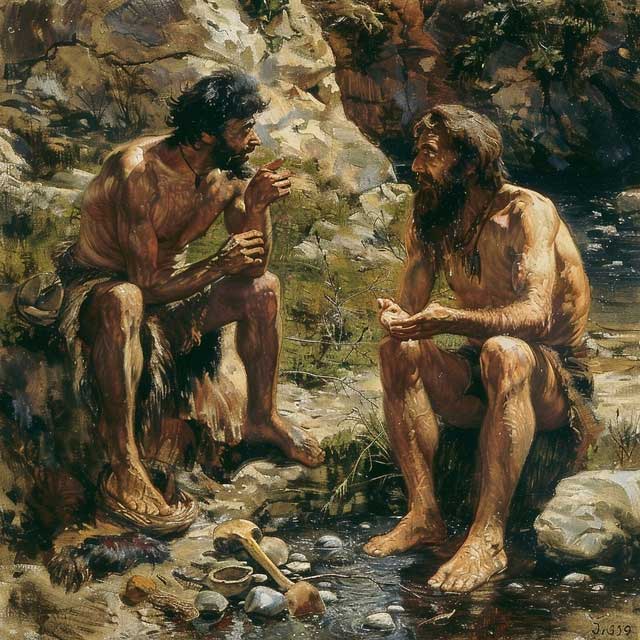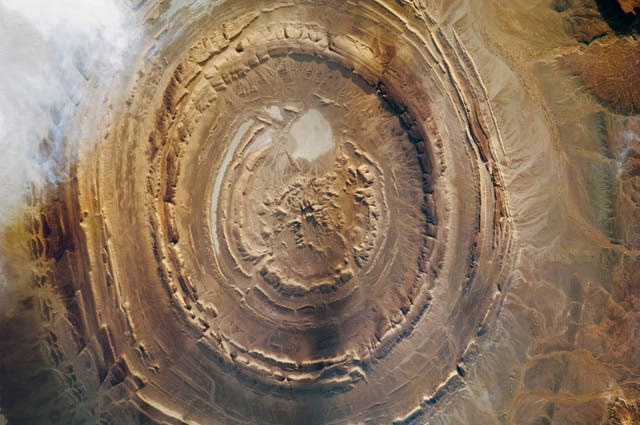1.6 million year old archaeological evidence changes people's view of language history
New research has shown when prehistoric people first started talking.
Conducted by archaeologist Steven Mithen, new research reports that humans developed language abilities 1.6 million years ago, in the wilds of Southern Africa .

Early versions of the ancient language appeared at least eight times earlier. (Illustration).
' No one can doubt that humans developed physically and culturally thanks to the ability to speak. That's why determining when the first language appeared is so important ,' Professor Mithen, who specializes in prehistory at the University of Reading, told The Independent.
Previously, most experts believed that humans only started talking about 200,000 years ago. But in the new report, Professor Mithen suggests that the early version of the ancient language appeared at least eight times earlier. The professor came to this conclusion based on evidence available at excavation sites, in genes and in ancient human anatomy, in addition to some other linguistic evidence.
Putting them together, he suggests that the birth of language took place between 1.5 and 2 million years ago .

Richat structure in the Sahara desert, which is believed to be the cultural center of prehistoric Homo Erectus - (Photo: NASA).
There is another important factor. The size of the human brain has increased significantly , especially since 2 million years BC, then increased rapidly in size after 1.5 million years BC. The increase in size is accompanied by a structural reorganization within the brain – including the first appearance of the frontal lobe, specifically related to thinking, imagination and cognitive functions. This contains a region called 'Broca', which scientists believe is involved in language production and language comprehension.
New scientific research also shows that the appearance of Broca's area is related to improvements in memory storage - an important factor for forming sentences. But other evolutionary developments were also important for the birth of early language.
Two factors that accompanied humans at the dawn of evolution, the ability to walk on two legs and the change in skull shape, likely contributed to the process of changing the shape and position of the skull. respiration, thereby helping people have a voice.

Homo erectus, believed to be the first human species capable of speaking - (Photo: Internet).
Another crucial piece of evidence appears in 1.6 million years BC (which is also when humans could begin to speak) appearing in archaeological sites. When compared to contemporary species, humans are especially weak, so our ancestors had to possess another 'weapon' to gain the upper hand.
During evolution, it is almost certain that language was part of a strategy to compensate for physical strength. To hunt large animals (or when gathering, to repel stronger animals), early humans needed better planning and group coordination - the development of language was paramount in this context.
Humans began hunting about 2 million years ago, and hunting efficiency increased significantly around 1.5 million years ago. Around 1.6 million years BC, history written on fossils shows the birth and transmission of culture through generations, and stone tools became much more effective. High capacity for spoken language helped prehistoric humans transfer complex knowledge and skills from one generation to the next.

Progress in human tool creation, from 1.75 million years ago to 850,000 years ago - (Photo: Los Alamos National Laboratory).
Yet, linguistic communication can help humans survive in different ecological and climatic zones - perhaps it's no coincidence that humans can dramatically increase the rate at which they settle around the world. about 1.4 million years ago, just after the time when language is believed to have begun. This tool has helped people do three important things to shape the future: visualize to make plans, and communicate knowledge.
" That's how language has profoundly changed human history ," according to Professor Mithen. His new research suggests that before the advent of language, human communication was extremely limited, perhaps consisting of only a few dozen different sounds and hand gestures.
Over the past hundreds of thousands of years, language gradually evolved and became complex to reach the sophisticated level it is today. In modern times, we not only use language to chat with each other, but also invent new languages, such as programming languages to chat with computers.
- Programming language history
- Discover and excavate many archaeological archaeological sites of the Stone Age
- Brain size is more important than gender
- 3 most mysterious archaeological discoveries in human history
- Unique new year greetings in the world
- 7 archaeological discoveries are 'going the right way' with science, so far no one has explained it
- Beer helps civilization grow faster
- 400 new information about discovery, archaeological research
- Discover the forgotten language in Turkey
- Decoding the case of shocking network after 4,000 years
- Dead Sea scrolls and important archaeological findings in 2017
- Restoring ancient language
 Discovered an ancient centipede fossil 99 million years old
Discovered an ancient centipede fossil 99 million years old Discovered bat-like dinosaurs in China
Discovered bat-like dinosaurs in China Discovered a 200-year-old bronze cannon of the coast
Discovered a 200-year-old bronze cannon of the coast Discover 305 million-year-old spider fossils
Discover 305 million-year-old spider fossils If you put babies together without anyone teaching them to speak, will a new language emerge?
If you put babies together without anyone teaching them to speak, will a new language emerge?  Mysterious stone tablet at the bottom of the lake carries a language previously unknown to science
Mysterious stone tablet at the bottom of the lake carries a language previously unknown to science  Why do almost all languages obey Zipf's law?
Why do almost all languages obey Zipf's law?  Mysterious language, only twins can understand
Mysterious language, only twins can understand  The Future of TESOL: How Technology Transforms Language Learning
The Future of TESOL: How Technology Transforms Language Learning  Egyptian Pharaoh's Experiment: Without Teaching Babies to Talk, Can They Create New Languages?
Egyptian Pharaoh's Experiment: Without Teaching Babies to Talk, Can They Create New Languages? 